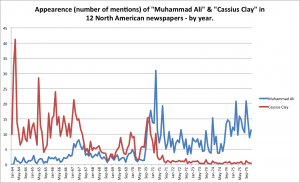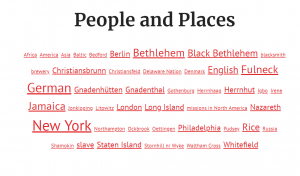After transcribing and reading our memoir about Elizabeth Grundy, Voyant Tools allowed me and my group to visualize our text in a new fashion. Once we had taken some time to assess our memoir, we came up with a research question stated as: “How does the frequency of the key terms change throughout the document?” As Professor Faull told us in class, most groups have some of the same key terms (savior, god, jesus). So our question was designed to see how and when Elizabeth Grundy decided to use these terms throughout her memoir.
Elizabeth Grundy’s memoir is about her journey through faith as she lost loved ones. The loss of her father, her husband, and her eldest child, all through illness, had her confused about her true beliefs. This helps lead us into the five key terms that were used throughout the entire memoir: ‘savior’ used 34 times; ‘time’ used 18 times; ‘son’ used 17 times; ‘god’ used 16 times; ‘jesus’ used 16 times. This is my first real use of distant reading which Whitley describes as, “looking over the broad patterns of a text.”
The first tool I used to help visualize these terms was Cirrus. Cirrus is a word cloud that visualizes the most frequently used terms in a document. Even though Cirrus is one of the most common tools of visualization, it plays an important role in distant reading. Cirrus is very useful because not only does it show the five most frequent terms that appear in the Summary tab on Voyant, but also the frequency of other words. This helped us answer our research question because it gave us a nice baseline visualization on the frequency of words in our memoir.
[iframe style=’width: 424px; height: 294px;’ src=’//voyant-tools.org/tool/Cirrus/?corpus=486449dbc605c4e77ecaa99e423bb935′][/iframe]
While Cirrus gives the frequencies of words, StreamGraph works a little differently. Streamgraph is a Voyant tool that depicts the change in frequency of words in a document or corpus. It splits up your text into ‘Document Segments’(the x-axis) and that helps you determine from the graph how often words were used in which segments. “Savior” is the most frequent term in our document and, based on the StreamGraph, it is also the most frequently used word throughout the memoir. What I mean by this is that ‘savior’ was not just used 30 times in one section then forgotten about, it was the most spread out word in the memoir. This Voyant tool helps us answer our research question because it shows the relative frequency of the five most frequent words. With this we can assess how often terms are used in which parts of the memoir. For example, around Document Segment 15, we see that the term “jesus” was used a whole lot of times whereas it was hardly used in the beginning of the text.
[iframe style=’width: 424px; height: 294px;’ src=’//voyant-tools.org/tool/StreamGraph/?docId=c07c78025c913d7a2670603c760ceb25&corpus=486449dbc605c4e77ecaa99e423bb935′][/iframe]
Now that we had figured out frequencies and relative frequencies of the key terms, we decided to work a little with their collocates. Using WordTree, we were able to identify how Grundy was using these terms in her memoir. While I was expecting four of the five key terms in our document (savior, god, jesus, and son-because she had two sons), I was a little confused as to why time was one of the key terms. In the WordTree for time, three of the five left continuations are ‘another’,’this’, and ‘any’. With these continuations, Grundy is telling us stories of her life at these instances (another time…, this time…, any time…). This Voyant tool helped us answer our question because it put into perspective how Grundy was using these terms. All of these tools helped us “perceive patterns in data that we may have otherwise missed”(187) and helped guide us along to answer our research question.
[iframe style=’width: 424px; height: 294px;’ src=’//voyant-tools.org/tool/WordTree/?query=savior&corpus=486449dbc605c4e77ecaa99e423bb935′][/iframe]
So while the StreamGraph was the most direct answer to our research question, the Cirrus helped us discover what other terms were frequently used, and the WordTree helped us figure out collocates of the five terms so that we knew the context she used those terms in.
Johanna Drucker defined visualization in the Whitley reading as a way to “integrate interpretation into digitization in a popular way” and I believe that exploring Voyant with our memoir and these tools made for a very enjoyable assignment.
Mitch Gavars is a student at Bucknell University where he is a part of the swim team. Mitch is from Barrington, IL and has one sister. His favorite movie is Aladdin.



